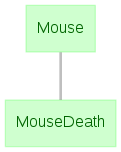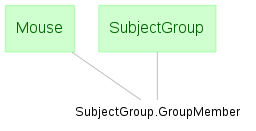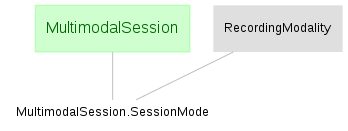Data Integrity¶
The term data integrity describes guarantees made by the data management process that prevent errors and corruption in data due to technical failures and human errors arising in the course of continuous use by multiple agents. DataJoint pipelines respect the following forms of data integrity: entity integrity, referential integrity, and group integrity as described in more detail below.
Entity integrity¶
In a proper relational design, each table represents a collection of discrete real-world entities of some kind. Entity integrity is the guarantee made by the data management process that entities from the real world are reliably and uniquely represented in the database system. Entity integrity states that the data management process must prevent duplicate representations or misidentification of entities. DataJoint enforces entity integrity through the use of primary keys.
Entity integrity breaks down when a process allows data pertaining to the same real-world entity to be entered into the database system multiple times. For example, a school database system may use unique ID numbers to distinguish students. Suppose the system automatically generates an ID number each time a student record is entered into the database without checking whether a record already exists for that student. Such a system violates entity integrity, because the same student may be assigned multiple ID numbers. The ID numbers succeed in uniquely identifying each student record but fail to do so for the actual students.
Note that a database cannot guarantee or enforce entity integrity by itself. Entity integrity is a property of the entire data management process as a whole, including institutional practices and user actions in addition to database configurations.
Referential integrity¶
Referential integrity is the guarantee made by the data management process that related data across the database remain present, correctly associated, and mutually consistent. Guaranteeing referential integrity means enforcing the constraint that no entity can exist in the database without all the other entities on which it depends. Referential integrity cannot exist without entity integrity: references to entity cannot be validated if the identity of the entity itself is not guaranteed.
Referential integrity fails when a data management process allows new data to be entered that refers to other data missing from the database. For example, assume that each electrophysiology recording must refer to the mouse subject used during data collection. Perhaps an experimenter attempts to insert ephys data into the database that refers to a nonexistent mouse, due to a misspelling. A system guaranteeing referential integrity, such as DataJoint, will refuse the erroneous data.
Enforcement of referential integrity does not stop with data ingest. Deleting data in DataJoint also deletes any dependent downstream data. Such cascading deletions are necessary to maintain referential integrity. Consider the deletion of a mouse subject without the deletion of the experimental sessions involving that mouse. A database that allows such deletion will break referential integrity, as the experimental sessions for the removed mouse depend on missing data. Any data management process that allows data to be deleted with no consideration of dependent data cannot maintain referential integrity.
Updating data already present in a database system also jeopardizes referential integrity. For this reason, the DataJoint workflow does not include updates to entities once they have been ingested into a pipeline. Allowing updates to upstream entities would break the referential integrity of any dependent data downstream. For example, permitting a user to change the name of a mouse subject would invalidate any experimental sessions that used that mouse, presuming the mouse name was part of the primary key. The proper way to change data in DataJoint is to delete the existing entities and to insert corrected ones, preserving referential integrity.
Group integrity¶
Group integrity denotes the guarantee made by the data management process that entities composed of multiple parts always appear in their complete form. Group integrity in DataJoint is formalized through master-part relationships. The master-part relationship has important implications for dependencies, because a downstream entity depending on a master entity set may be considered to depend on the parts as well.
Relationships¶
In DataJoint, the term relationship is used rather generally to describe the effects of particular configurations of dependencies between multiple entity sets. It is often useful to classify relationships as one-to-one, many-to-one, one-to-many, and many-to-many.
In a one-to-one relationship, each entity in a downstream table has exactly one corresponding entity in the upstream table. A dependency of an entity set containing the death dates of mice on an entity set describing the mice themselves would obviously be a one-to-one relationship, as in the example below.
@schema
class Mouse(dj.Manual):
definition = """
mouse_name : varchar(64)
---
mouse_dob : datetime
"""
@schema
class MouseDeath(dj.Manual):
definition = """
-> Mouse
---
death_date : datetime
"""

In a one-to-many relationship, multiple entities in a downstream table may depend on the same entity in the upstream table. The example below shows a table containing individual channel data from multi-channel recordings, representing a one-to-many relationship.
@schema
class EEGRecording(dj.Manual):
definition = """
-> Session
eeg_recording_id : int
---
eeg_system : varchar(64)
num_channels : int
"""
@schema
class ChannelData(dj.Imported):
definition = """
-> EEGRecording
channel_idx : int
---
channel_data : longblob
"""

In a many-to-one relationship, each entity in a table is associated with multiple
entities from another table.
Many-to-one relationships between two tables are usually established using a separate
membership table.
The example below includes a table of mouse subjects, a table of subject groups, and a
membership part table listing the subjects in each group.
A many-to-one relationship exists between the Mouse table and the SubjectGroup
table, with is expressed through entities in GroupMember.
@schema
class Mouse(dj.Manual):
definition = """
mouse_name : varchar(64)
---
mouse_dob : datetime
"""
@schema
class SubjectGroup(dj.Manual):
definition = """
group_number : int
---
group_name : varchar(64)
"""
class GroupMember(dj.Part):
definition = """
-> master
-> Mouse
"""

In a many-to-many relationship, multiple entities in one table may each relate to multiple entities in another upstream table. Many-to-many relationships between two tables are usually established using a separate association table. Each entity in the association table links one entity from each of the two upstream tables it depends on. The below example of a many-to-many relationship contains a table of recording modalities and a table of multimodal recording sessions. Entities in a third table represent the modes used for each session.
@schema
class RecordingModality(dj.Lookup):
definition = """
modality : varchar(64)
"""
@schema
class MultimodalSession(dj.Manual):
definition = """
-> Session
modes : int
"""
class SessionMode(dj.Part):
definition = """
-> master
-> RecordingModality
"""

The types of relationships between entity sets are expressed in the Diagram of a schema.